Got a Bee or Wasp Sting? Treat Them With These Home Remedies!
Got a Bee or Wasp Sting? Treat Them With These Home Remedies! By Horizon Pest Control If you or someone you know gets stung by
At first glance, it’s easy to mistake one stinging insect for another. You may know many people who apply the term “bee” to similar-looking bugs like wasps and hornets. However, knowing the difference between these insects is essential to understanding their behavior, knowing how to coexist with them peacefully, and determining which solution is most effective and eco-friendly if pest control becomes necessary.
Below, we’ll explain how to tell the difference between six stinging insects you’re likely to find near your New Jersey or New York home:
Honeybees
Bumblebees
Carpenter Bees
Hornets
Paper Wasps
Yellowjackets
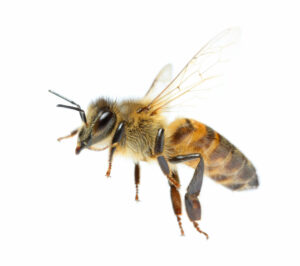
The honeybee is one of the most common bee varieties on the planet, though recently, there has been a concerning decline in the worldwide population. These bees are one of our planet’s most important pollinators. Yearly, their pollination supports $20 billion worth of U.S. crop production!
Honeybees have a somewhat thin, bullet-shaped body covered in tiny hairs, and it’s relatively easy to distinguish its head from its abdomen. You can also clearly see the set of front wings and back wings. Their bodies have black stripes and can be various shades of orange or amber. When they fly, honeybees tuck their legs in.
Honeybees aren’t particularly aggressive and typically will only sting if provoked. You can often find these little bugs collecting pollen or nectar from flowers, which they use to produce honey that humans can consume. Honeybees live in colonies containing thousands of members. When beekeepers do not manage them, these colonies are often found in hollow trees. Occasionally, these bees will also take over a manmade birdhouse or the hollow area of a building.
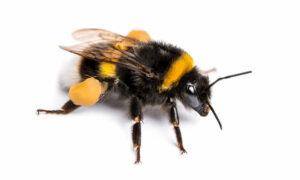
The bumblebee is another of Earth’s most common bee varieties and another valuable pollinator. A bumblebee’s body is fuzzy and rounder than the honeybee’s. Unlike many other stinging insects, there isn’t a clear distinction between the bumblebee’s head and its abdomen, giving it even more of a round appearance.
These furry-looking insects are striped with black, white, and orange-yellow. At first, it often looks like bumblebees only have one set of wings, but they have a pair of front wings and a tiny pair of rear wings attached to the front ones. When they do fly, bumblebees let their legs hang down, unlikes their cousin, the honeybee.
Rather than living in hives, bumblebees live in nests with a few hundred other colony members, and you will typically find these nests in underground burrows or piles of compost or leaves. Like their cousins, the honeybees, bumblebees are not one of the more aggressive stinging insects and generally will not sting unless provoked. Also like honeybees, bumblebees produce honey, except these bees consume it all themselves.
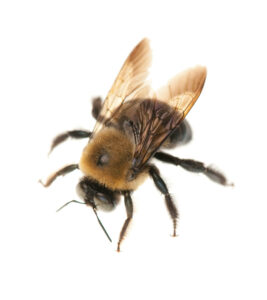
Unlike honeybees and bumblebees, carpenter bees are less known for pollination and are more infamous for the damage they cause to wooden structures and framework. All carpenter bees have a distinctive abdomen (back end) that’s black and shiny. A carpenter bee’s thorax (middle section) can be yellow, black, brown, white, or even blue, depending on the species.
Rather than living in colonies, carpenter bees live alone. A female will hover around a wooden surface (a fence, deck, siding, etc.) until she finds a place to make a tunnel and lay her eggs. If she feels like her eggs are threatened, she may sting. Male carpenter bees are unable to sting but may fly aggressively around you.

Unbeknownst to many, hornets are a type of social wasp. They are part of the Vespidae family, making them related to paper wasps and yellowjackets. Hornets often have a dark brown body and an orange-yellow head and orange-yellow stripes on the abdomen.
At around one inches in length, they’re typically larger than the average honeybee, and their bodies are also thicker than those of yellow jackets or paper wasps. They will also appear to have less hair compared to a bee. When hornets fly, you’ll see their legs hang down.
Hornets can become very aggressive if they feel that their nest is in danger. The tricky part is that hornets like to build their nests in various places: indoors, outdoors, underground, in treetops, tree hollows, roof eaves, attics, etc. A hornet’s nest will look like a papery ball or teardrop and can be as large as a basketball. If you see a hornet’s nest, keep several yards away from it, and avoid making loud noises that might startle the occupants and raise the alarm (such as using a leafblower).
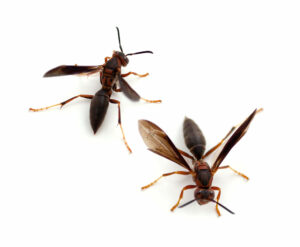
Like hornets, paper wasps can be beneficial in keeping aphids and caterpillars populations under control in your garden. However, sharing the same space as these stinging insects isn’t easy if they build their nests close to your home’s high traffic areas, like the front door.
Paper wasps are brown and typically have yellow markings, although some may have reddish markings, depending on the species. They have the characteristic wasp “waist” (very thin and pronounced) and particularly long legs (when compared to bees and other wasps) that they let dangle when they fly. They have only one pair of wings.
You’ll most often find paper wasp’s wood-pulp nests under a house’s eaves, but they can also be found in places like sheds, attics, garages, trees, and shrubs. The nest hangs downward and contains a single plane of hexagonal cells (similar in appearance to a honeycomb). Paper wasps are unlikely to sting you when they’re out and about, but if you get too close to their nest, they can become very hostile.
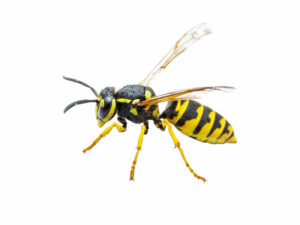
Yellowjackets are the stinging insects that are most likely to show up uninvited to an outdoor birthday or cookout: these bugs love sweets! Their heads are yellow and black, and their bodies have yellow and black band-like markings and tend to look more slick and smooth than hairy. They also have the tiny “wasp waist” and four wings. Unlike paper wasps, yellowjackets tuck their legs under their bodies when they fly.
Yellowjacket nests can contain thousands of colony members. The nests are constructed of chewed-up cellulose and can be found in lofty or cavernous locations (like attics and eaves) or underground. The nest will have one opening and can be hard to see, which can lead to a nasty encounter if you’re not careful. Yellowjackets typically will be drawn to sweet-smelling things like food, uncovered garbage, and even fruity perfume.
In terms of aggression, yellowjackets generally pose a greater risk than paper wasps. Yellowjackets often sting unprovoked, and if they feel their nest is in danger, they will swarm.
If left alone, stinging insects generally will not cause you harm. However, sometimes it’s necessary to remove their nests to protect your family and neighbors. The venom of just one stinging insect can be life-threatening to someone who’s allergic. Keep in mind that all of the insects discussed here except the honeybee can sting multiple times without harming themselves. If children or pets play near the hive or nest of a stinging insect, they may unknowingly provoke an attack that could have been prevented by professional insect removal.
For safe and responsible stinging insect removal, contact our experts at Horizon Pest Control online or by phone at (201) 447-2530.
Got a Bee or Wasp Sting? Treat Them With These Home Remedies! By Horizon Pest Control If you or someone you know gets stung by
Can Carpenter Bees Pose a Threat? Frequently Asked Questions and Answers By Horizon Pest Control What are Carpenter Bees? Carpenter bees are large, solitary insects
Preventing Bees and Wasps Around the Pool By Horizon Pest Control For those fortunate enough to have a backyard pool, the presence of bees and
